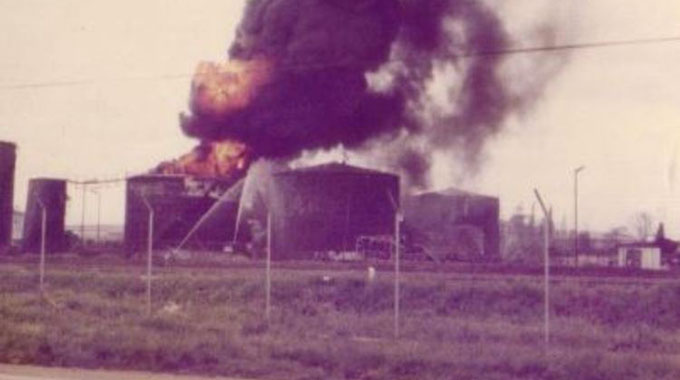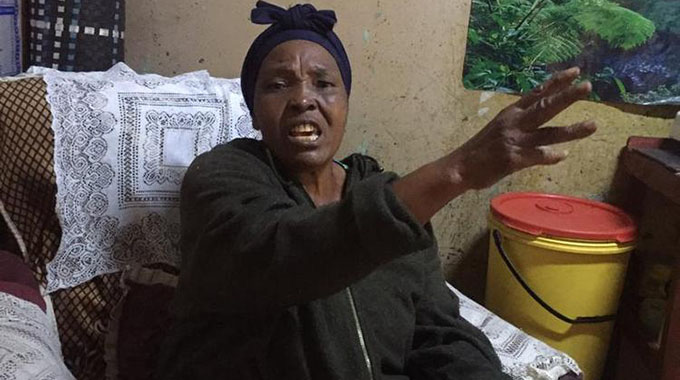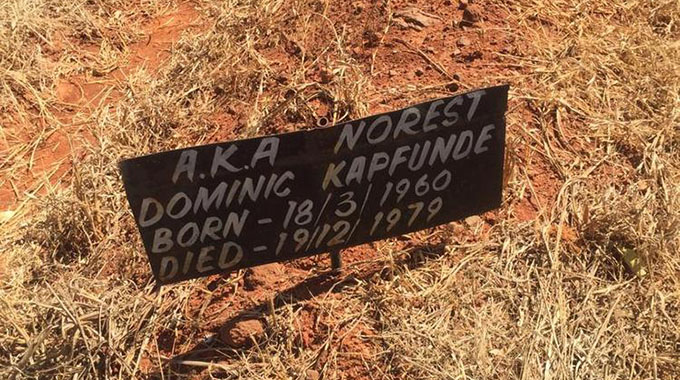
The Sunday Mail

Forward Nyanyiwa
THE 2020 Heroes Day commemorations will be held tomorrow, Monday, August 10, under the theme “Remembering Our Heroes”. The Sunday Mail remembers a freedom fighter, Dominic Kapfunde aka Cde Norest Muhondo, who at just 18 years of age undertook a daring military assault deep into the heart of Salisbury and attacked one of the major arteries that kept Ian Smith’s tightly-run racist economic system going. The mission, a defining moment of the protracted liberation struggle, required guerrillas that knew Rhodesia’s capital like the back of their hands. Thus, Cde Norest was partnered with Cdes Lobo, Member, Hwanda, Damage Bombs, States America Mudzvanyiriri, Take Time and Nhamo.
*********
ON December 19, 1979 two days before the Lancaster House Agreement was signed declaring a ceasefire signalling the end of the Second Chimurenga, Zimbabwe’s liberation struggle, a key figure of that war died a painful but heroic death.
Cde Norest, who was 19 at the time, had been captured movie-style the previous day together with Chief Zimbiru of Domboshava and a colleague.
After his capture following a tip-off by Ian Smith’s informants, Cde Norest was brought before the whole village to be killed as an example to everyone, in a horrific spectacle that gave a graphic illustration of the brutal nature of the colonial regime.
The unforgiving Rhodesian Front (RF) soldiers bound both his hands and feet before tying him to a horse.
However, even as they were tying him up, Cde Norest, who had earlier been heavily tortured, told his captors that he was dying a satisfied soul, knowing he had played his part freeing his motherland.
The horse was then set off and he died from injuries sustained from being dragged — crashing into boulders, trees and other objects through which the horse was being driven.
Good evening General Peter Walls
A year earlier, Cde Norest had been entrusted with pulling the trigger from his M90 rocket launcher which torched the Shell oil tanks during that unforgettable night on December 11, 1978, an act of bravery which surprised even his commander given his youthful frame.
As he let out the second missile on that chilly night, when time seemed to freeze, stopped by the gravity of the act, he reportedly said, “Good evening General Peter Walls” — a sarcastic gesture probably to remind the then Rhodesian army chief that the war had “reached another level”.
So devastating was his shot that a golden fireball shot up to the sky at once, lighting the sleepy Willowvale industrial area, Mbare and Rugare suburbs.
It took a fortnight, with the help of apartheid South African firefighters, to douse the flames.

The Shell oil tanks which were torched by Cde Norest and team during that unforgettable night on December 11, 1978
This attack was a major turning point in the history of Zimbabwe’s liberation struggle, forcing Ian Smith to the negotiation table.
After bombing the oil tanks, Cde Norest and another colleague from their team retreated to Zimbiru Village, Domboshava.
According to Member Manjonjori a.k.a Cde Kuvhiringidza, who was the commander of that mission, Cde Norest was supposed to have returned to Mozambique with them but he refused to return without his gun — the M90 rocket launcher, which had been borrowed by another comrade for a different mission in Harare.
A different group had been assigned to partake a similar combat at the Harare International Airport and that is how his weapon was borrowed.
Cde Norest then decided to join a colleague in Domboshava who had been assigned to initiate a Harare detachment as the freedom fighters scaled up their war efforts by penetrating the capital city.
Unbeknown to Cde Norest, Domboshava was heavily infested with Smith’s secret operatives and informants. His decision to stick around was not only against a direct command, but proved fatal.
So brutal was his death that 39 years after the killing, his skull had visible fractures sustained from the brutal execution.
And, instead of allowing locals to bury the body, Rhodesian soldiers shoved the corpse into a “secret cave” in a river hoping his remains would be washed away and never be found.
As fate would have it, that was to be his resting place for 39 years. No one knew the exact place he had been “buried”.
Marine creatures feasted till only bare bones were left and weather elements did the rest.
But for four decades, the flowing river could not wash away everything. In 2018, Cde Norest’s sister managed to track down her brother’s remains for a proper reburial.
Brief reunion
Ms Juliet Kapfunde, Cde Norest’s elder sister, could not hold back tears as she narrated the heart-rending ordeal.

Ms Kapfunde
“My brother’s death haunts me to this day, it’s not a closed chapter,” began Ms Kapfunde’s narration.
“Dominic didn’t finish school like many young people back then. We were in Mutoko, our rural home, when we all planned to go to Mozambique. Unfortunately, I fell pregnant and Dominic decided to leave me behind. He was a jovial person and I vividly recall the night he went away as he jokingly lied that he was going to the shops.”
That was the last time she would see him until he resurfaced in 1978 at their home in Glen Norah, Harare.
“Dominic just went away only to come back in 1978 in Glen Norah. I tried to hug him but he turned me down saying he was still in the bush. Sadly the reunion did not go well. He sent my daughter to buy him a bottle of Coca-Cola and biscuits but the child never returned. She was run over by a car, prompting police and soldiers to come to our home.
“Dominic vanished. I asked myself how he could just leave me grieving. That was to be the last time I saw him alive,” said Ms Kapfunde.
Later, she heard that the Shell oil tanks had been bombed and that her brother was part of the team that had successfully executed the mission.
Ms Kapfunde said after the war, their parents waited in vain for their son’s return until they both passed on. On her deathbed, their mother is said to have asked her daughter to “look for Dominic”.
It was to be a wild goose chase.
Finding Dominic
Ms Kapfunde had a breakthrough in 2017 at one of former First Lady Grace Mugabe’s rallies where foodstuff was donated to Gogo Hwiza, the elderly woman who housed Cde Norest and his group before their mission.
“After the war, my mother was crying all the time. She thought he would come back. She later died without seeing him but she told me to continue the search,” she said.
“I was told to go to Zimbiru Village in Domboshava.
“With the help of Mr Chinyani from Zinatha and the locals there, we went to a river between two mountains and there the remains of my brother were still suspended in the cave on the river bed.”
But how did they positively identify Cde Norest? Did they conduct DNA tests on the bones or was it just guess work?
“Upon reaching the site, I somehow saw his face. He was standing there beckoning me to come near him. I had my uncle, our mother’s brother who also said he was seeing Domy,” said Ms Kapfunde, admitting that they were guided spiritually by Zimbabwe Traditional Healers Association’s Sekuru Chinyani.
As expected, the skull they found had fractures from the fatal injuries 39 years prior. They also found a few ribs but that was enough for the family that had waited almost four decades.
With the help of the Second Republic, the family ferried people from Mutoko where they performed all rituals before returning to Harare to bury the body at the Harare Provincial Heroes Acre.
Recognition
The family seeks to have Cde Norest properly recognised.
Zimbabwe National Liberation War Veterans Association (ZNLWVA) chairman Cde Chris Mutsvangwa revealed that Cde Norest was part of the few commandos who were trained by the late Air Chief Marshal (Rtd) Perrance Shiri, who knew the geography of Harare.

Cde Norest’s final resting place at the Harare Provincial Heroes Acre
Cde Mutsvangwa said the Second Republic was now trying to correct the wrongs made.
“Remember even the ZANLA commander General Josiah Magama Tongogara was only honoured by President Mnangagwa. The King George KGVI Barracks were renamed after him following Operation Restore Legacy.
“As the Second Republic we need to look further into these issues. We can yet still bring closure to the heroic events of that epoch of national pain, death and sacrifice. We should try to resolve all outstanding matters because we have the information with us. After all, people who fought or witnessed the war are still alive.”
Cde Mutsvangwa said it was not too late for wrongs to be corrected and for reburials to be conducted.
“The Bible was written well over three decades after the death of Jesus Christ. We can still collate that history. As a short-lived Minister of the War Veterans and the chairman of war veterans I reached out to UNESCO sub regional director Dr Hubert Gijzen. He responded positively and actively,” said the War Veterans supremo.
Defence and War Veterans Affairs Minister Cde Oppah Muchinguri said she would visit Cde Norest’s grave and see what can be done to help.
“I was not aware of that, but I will personally visit the site and see to it that the comrade gets a decent grave. It’s not him alone but a lot of them. At one time we had to rebury more than 30 people whom we recovered from a cave,” she said.
“My ministry, with the help of the department of museums is now collating every minute detail of those who perished even outside the country and putting up shrines.
“The President will soon initiate a fund to help the comrades and families left behind. We will have farms, projects and companies, among other initiatives, to empower our heroes.
“The Constitution demands dignity of war veterans. It is something that was not being done before. We are bringing back the respect those fallen and alive deserve.”
At independence, friends and families were reunited with their sons and daughters that trooped back from assembly points, but some waited in vain while others are still waiting.
From Chimoio to Nyadzonia, Mkushi, Doroi and Tembwe — among many others — many still lie in unmarked graves.



